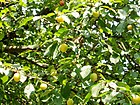Note: This is a project under development. The articles on this wiki are just being initiated and broadly incomplete. You can Help creating new pages.
Prunus domestica
Prunus domestica is a deciduous shrub or a tree usually growing 2 - 6 metres tall, occasionally to 15 metres. The plum is very widely cultivated, both commercially and in gardens, for its edible fruit. The plant also has a number of other uses, as food, medicine and a source of materials.
Contents
- 1 Uses
- 2 Parts Used
- 3 Chemical Composition
- 4 Common names
- 5 Properties
- 6 Habit
- 7 Identification
- 8 List of Ayurvedic medicine in which the herb is used
- 9 Where to get the saplings
- 10 Mode of Propagation
- 11 How to plant/cultivate
- 12 Commonly seen growing in areas
- 13 Photo Gallery
- 14 References
- 15 External Links
Uses
Stimulates respiration, Indigestion[1]
Parts Used
Chemical Composition
The main polyphenolic compounds present in plums are phenolic acids, such as chlorogenic acids, anthocyanins, flavanols, flavonols, and coumarins [9,10,11], which have been found to have numerous pharmacological effects, including antioxidant activity, anticancer, antimutagenic, and anti-inflammatory properties .[2]
Common names
| Language | Common name |
|---|---|
| Kannada | |
| Hindi | |
| Malayalam | |
| Tamil | |
| Telugu | |
| Marathi | |
| Gujarathi | |
| Punjabi | |
| Kashmiri | |
| Sanskrit | |
| English |
Properties
Reference: Dravya - Substance, Rasa - Taste, Guna - Qualities, Veerya - Potency, Vipaka - Post-digesion effect, Karma - Pharmacological activity, Prabhava - Therepeutics.
Dravya
Rasa
Guna
Veerya
Vipaka
Karma
Prabhava
Habit
Identification
Leaf
| Kind | Shape | Feature |
|---|---|---|
Flower
| Type | Size | Color and composition | Stamen | More information |
|---|---|---|---|---|
| {{{5}}} |
Fruit
| Type | Size | Mass | Appearance | Seeds | More information |
|---|---|---|---|---|---|
Other features
List of Ayurvedic medicine in which the herb is used
Where to get the saplings
Mode of Propagation
Seeds, Cuttings of half-ripe wood, Softwood cuttings, Layering in spring.
How to plant/cultivate
The plum is fairly cold-hardy, able to tolerate temperatures down to around -20°c when dormant.[4]
Commonly seen growing in areas
Photo Gallery
References
- ↑ Indian Medicinal Plants by C.P.Khare
- ↑ Chemical constituents
- ↑ [Morphology]
- ↑ Cultivation
External Links
- Ayurvedic Herbs known to be helpful to treat Stimulates respiration
- Ayurvedic Herbs known to be helpful to treat Indigestion
- Herbs with Fruits used in medicine
- Herbs with Seeds used in medicine
- Habit - Deciduous tree
- Index of Plants which can be propagated by Seeds
- Index of Plants which can be propagated by Cuttings of half-ripe wood
- Index of Plants which can be propagated by Softwood cuttings
- Index of Plants which can be propagated by Layering in spring
- Herbs that are commonly seen in the region of Found in hedges
- Herbs
- Pages without herbs images








